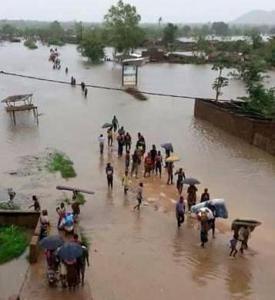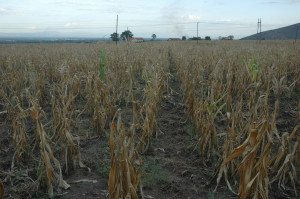With Malawi’s population hovering at 15 million and 80 percent living in rural areas, agricultural and environmental experts feel crop diversification and adoption of winter cropping using water harvested from floods or rainfall would help the country have abundance food.

Chrissy Chidikha, Village Head (VH) from Kadzumba Traditional Authority (T/A) Maseya in Chikwawa District and a victim of heavy flooding, has lived a miserable life for the past years.
Even today, Chidikha does not hide her discontent at how crops were washed away and family squeezed in a tent or school block for shelter due to floods, a typical example of climate change faced not only in Malawi but globally.
Making matters worse, all her land was being submerged in water, leaving her with no food to feed her husband and three children.
And when the flooding period is over her land situated 100 metres from Shire River is left with many swamps, potential areas for winter cropping and the practice of climate smart Agriculture-CSA
“I have lived a miserable life such that even after the floods, dependency on handouts was the order of the day,” she said.
Like Chidikha, Ronald John is another villager from the same area, who has no kind words for floods. He too has depended on relief support for a living, which is not enough to take them throughout the year.
“The relief support is not always enough and it’s a challenge for us. This is why life without food is meaningless and in fact, you cannot raise a family by begging,” he said referring to how bad it is to be a flood victim.
But such perennial problems are history for both Chidikha and John since Stephanos Foundation introduced small scale farming and winter cropping activities taking advantage of water from floods and swamps.

Communities have also taken upon themselves to ensure that once floods are over they grow crops such as rice, sweet potatoes, beans, maize to save their families from hunger through irrigation and treadle pumps.
Said John: “We missed the point as we did not think of growing crops or practice climate smart agriculture, CSA in our areas so that we harvest before the rainy season.”
Upon a visit in Kadzumba Village, John and Chidikha likewise other communities were busy watering their crops using watering canes and treadle pumps. The crops look promising.
“I have four plots of rice from which I expect to harvest more than 22 bags. At the same time we are also into crop diversification because I also grow maize and beans,” Chidikha said.
In the previous years, she used to harvest less than four bags of rice, until they were trained to use the available swamps to plant rice once floods ceases by Stephanos Foundation, which introduced the food security programme through small scale farming and crop diversification.
On the other hand, John has a farm where he plants trees annually whose leaves revamps fertility of soils after a thorough decomposition process.
“I am also into mulching, utilisation of green manures, conservation tillage and conservation agriculture,” said John aged 48 years.
Stephanos Foundation has similar projects in Nsanje, Zomba and Blantyre to ensure that flood affected people have food.
“We want to ensure that people utilise the abundant water, swamps or waterlogged areas to plant climate friendly crops. We provide training, seeds, treadle pumps and supervision for masses to practice the correct farming,” said programmes manager of Stephanos Foundation Chimwemwe Sallie Hara.
He hinted that K15 million was pumped into the programme to alleviate human suffering in the aftermath of floods through irrigation and crop diversification.
What communities and Stephanos Foundation are doing are in tandem with a broad range of agricultural water management policies and technologies.
These policies and technologies contribute to mitigation and adaptation through sustainable land and water management (SLWM) practices championed by TerrAfrica, a component of Nepad across the Africa region.
For Nepad officials many of these practices such as mulching, green manures, conservation tillage and conservation agriculture help land users to adapt in areas predicted to receive lower precipitation.
Nepad has also discovered that under present conditions, much rainwater is lost to agro-ecosystems as, for a variety of reasons, it does not infiltrate the soil but rapidly runs-off overland, limiting water availability for plant/crop growth, removing topsoil and deleteriously affecting hydrological regimes.
Besides rainwater such initiatives, a study of Malawi’s potential for irrigation carried out recently identified 57 potential sites.
Seven are in the North, 12 in the Centre and the South has 38. The 38 sites in the South 25 are in Shire Valley, which is prone to floods annually.
With this model, 69 percent of produce more than eight different crops, 89 percent of farmers are food secure and that 75 percent of farmers engage in business.
George Mhango, Blantyre, Malawi
This story was produced under the aegis of the CSE Media Fellowships Programme for the Global South.
